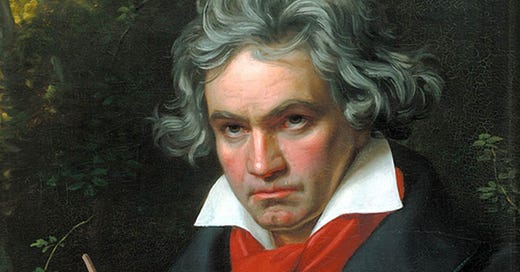Beethoven's Genome: Ancestry, Legacy and Disease
Analyses of Beethoven's genome reveals liver disease as a likely cause of death
Ludwig van Beethoven was a German composer and pianist who lived from 1770 to 1827. He is widely considered one of the greatest composers in Western classical music history. His vast body of work includes nine symphonies, numerous concertos and chamber music, and one opera. Beethoven's music is characterized by its emotional depth, innovation, and technical mastery and serves as a musical inflection point between the Classical and Romantic eras of music.
Beethoven’s medical status
Despite Beethoven’s exceptional talent, his health always troubled him. Beethoven lost his hearing, resulting in immense emotional turmoil. Despite this challenge, some of his most famous works were composed while deaf — the Ninth Symphony and "Moonlight" Sonata, for example. Beethoven also struggled with abdominal pains. His health issues worsened, and he eventually succumbed to symptoms similar to liver disease. His drinking habits likely did not help his liver condition; one of his friends noted that he would have a "liter of wine with lunch every day."
Although liver-related issues are a plausible cause of death, numerous researchers have debated his health woes. To muddy the water further, evidence from autopsy, documentation, and toxicological analysis has been shrouded in controversy. For example, sample authenticity is often questioned and, in some cases, determined to be inauthentic.
The question remains: What caused Beethoven’s death?
Ancestry and Legacy
To address this question, an international collaboration of researchers from the UK, Germany, Belgium, Estonia, and elsewhere decided to take a novel approach — genome sequencing — as reported in a recent publication in Current Biology. However, before addressing his health, they must determine that they have robustly sequenced Beethoven’s genome. To do so, Eight locks of hair attributed to him were sequenced using the latest developments in ancient DNA sequencing technologies. Using provenance, genetic sex determination, and haplotyping, researchers confidently determined five samples were from one European man — Beethoven.
Pedigree analysis between Beethoven and five living men from the Van Beethoven family failed to indicate a single patrilineage. How could this be? Given the robust authentication of Beethoven’s hair, one explanation is an extra-pair paternity event — wherein multiple males fathered a generation. The researchers suggest the genome sequences are likely that of Beethoven and that sample inauthenticity is likely not the cause.
Genetics and disease
Using the genome of Beethoven, the researchers were now poised to assess his health risks. Polygenic risk calculations indicated Beethoven is in the 96th risk percentile for liver cirrhosis. Moreover, the genome of Beethoven had a homozygous variant in the gene PNPLA3 that has been consistently associated with liver cirrhosis. In contrast, Beethoven’s polygenic risk scores for other diseases were lower.
Hepatitis virus infections are also associated with liver complications. Targeted sequencing revealed the presence of Hepatitis B in Beethoven’s hair. Although hair seems like a strange place to check for viruses, hair is a known potential reservoir for those suffering from Hepatitis B infections.
These compelling lines of evidence — polygenic risk scores and a potential Hepatitis B infection — coupled with hearty drinking suggest that liver disease is a likely culprit for Beethoven’s death.
Lessons learned
The sequencing of Ludwig van Beethoven's genome has shed new light on the life and death of one of history's greatest composers. Through modern technology, scientists have determined that Beethoven's cause of death was likely liver disease, which adds another layer of understanding to his health struggles throughout his life. By uncovering this information, we can gain a deeper appreciation for Beethoven's perseverance and artistic genius in the face of physical challenges and continue to be inspired by his music for generations to come.
Reference: Begg et al. Genomic analyses of hair from Ludwig van Beethoven (2023). Current Biology. DOI: 10.1016/j.cub.2023.02.041.
Connect with Genomely!
Substack: Genomely from Jacob L. Steenwyk
Twitter: @Genomely
GitHub: GenomelyBio
Connect with me!
Twitter: @jlsteenwyk
Website: jlsteenwyk.com





